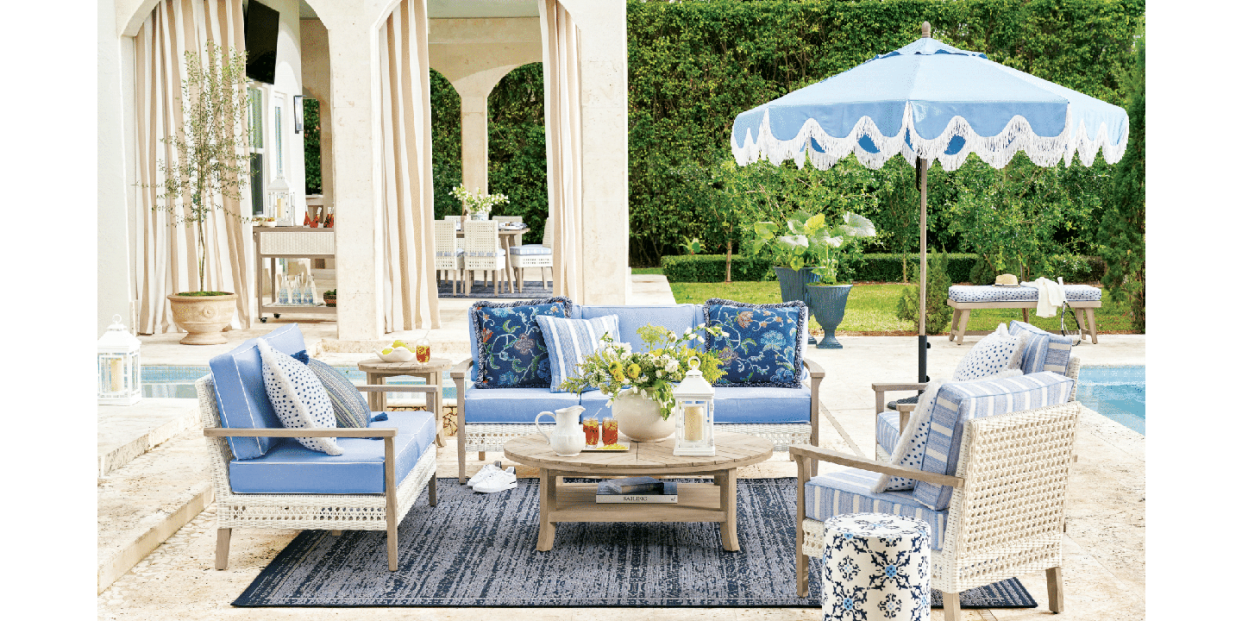How to Properly Clean Your Outdoor Furniture Before Your Next BBQ

The easiest way to get over the winter blues is by planning your first outdoor soirée of the spring season. But before you get into party planning mode, stop and clean your outdoor furniture cushions and furniture (add this to your spring cleaning checklist). Your outdoor furniture is an investment, and depending on climate conditions and how often you use it, maintenance is required. Although outdoor furniture is durable, it’s not impenetrable and can still get exposed to mold, mildew, and food stains like any piece of furniture. And especially if it’s been in storage all winter, you need to remove the covers, air it out, and clean it before you start entertaining your guests. Here are some of the best expert tips on cleaning wicker, wood, plastic, wrought iron, aluminum, and outdoor cushions. Then you can get back to doing what you enjoy the most, lounging outdoors and entertaining your friends.
Need outdoor furniture first? Shop the best here.
Plastic
Plastic is the easiest type of furniture to clean, as it typically comes with a glossy finish that's naturally stain-repellent. “When cleaning plastic, we recommend all-purpose cleaners made with natural oils and enzymes; it makes for a residue-free finish,” says Austin Miller, cofounder of Spruse, a Seattle-based cleaning company. “When cleaning plastic furniture, don’t use scouring pads, as it'll leave faint grooves and scratch marks on the surface cleaned. We always recommend using microfiber towels and then hosing down when done for an even dry.”
Wrought Iron
Wrought iron is a popular choice for outdoor furniture because of its durability. “We recommend using white cleaning vinegar and a non-scratch pad,” says Miller. “Gently scrub all areas, and when finished, wipe the areas with just a towel and water to remove excess dirt. Make sure not to use anything acidic, or anything that can scratch, as wrought iron can be damaged that way.”
Aluminum
Aluminum is another common option for benches, accent chairs, tables, and more. “Always remove cushions before getting to the frame of your aluminum furniture so as to have a fully exposed canvas before washing,” advise Anne and Will Massie, founders of heritage outdoor furniture brand McKinnon & Harris. “When cleaning the frame, we suggest using a cleaner designed for washing surfaces like cars and boats, like Meguiar’s Gel Wash. The premium wash is loaded with rich ingredients that protect the finish and give it that newly minted shine without striping off the wax protectant that was originally applied to the aluminum.” The pair also recommends using a soft cloth, such as a microfiber towel, smooth rag, or gentle sponge to work the cleaner into a soapy lather before simply rinsing away.
Outdoor Sofa Cushions
Do your sofa cushions come with a removable cover? This means you can simply throw them in the washing machine when they get dirty. Meanwhile, Ikea (whose outdoor sofa cushions do not have removable covers) advises hand washing. The brand recommends cleaning cushions sans removable covers with a sponge or cloth that has been dipped into soapy water. Simply wipe down the surface covers with soap and water, and then wipe dry with a clean cloth. If your outdoor sofa has already been infected with algae or mold, it should suffice to wash it with water and vinegar, and wash off the vinegar afterward.
Wicker
Wicker furniture can be woven from natural materials like rattan, bamboo, or cane or synthetic versions of these materials. “Natural materials like rattan, bamboo, or cane are naturally porous, which means they’ll soak up any moisture from being left in rainy or damp conditions,” advises Nicole Hunt, Product Development Manager at Article. Being that these natural materials have minimal UV resistance, they will fade or dry out in sunny and hot conditions. A good habit is to keep them in a covered outdoor space or store them inside when not in use. “To keep your wicker outdoor pieces looking great for years to come, brush off any dirt and debris with a soft nylon brush,” says Hunt. “A good rule of thumb is that if it’s gentle enough to brush your teeth with, it’s safe for the furniture. For a quick clean, use a minimally damp cloth to wipe your furniture down to clear off any dust or dirt that may have accumulated.”
Wood
Materials like teak, acacia, and eucalyptus are great choices for outdoor furniture as they are hardy materials and very resilient. While naturally weather-resistant, acacia can still be sensitive to moisture and humidity, while teak is naturally weather-resistant and resistant to fungus. “Caring for wood outdoor furniture is pretty simple,” says Hunt. “Wipe away any dirt using a damp, non-abrasive cloth. For more stubborn messes and spills, dip a cloth into some pH-neutral soap and warm water, wring out any excess liquid and wipe the spot clean. Then, either let it dry out naturally in the sun or dab the area with a clean dry cloth."
Follow House Beautiful on Instagram.
You Might Also Like
